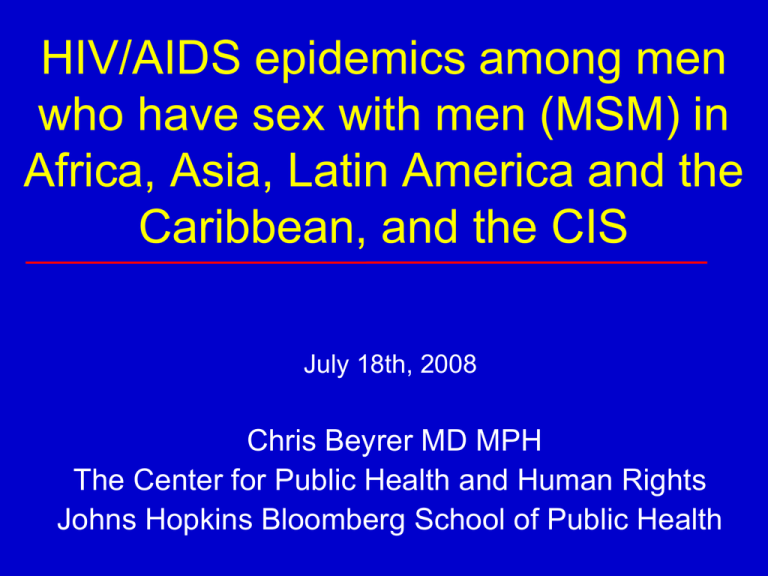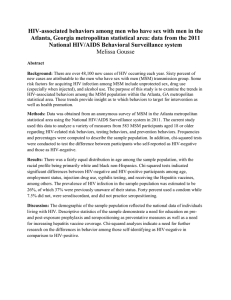
HIV/AIDS epidemics among men
who have sex with men (MSM) in
Africa, Asia, Latin America and the
Caribbean, and the CIS
July 18th, 2008
Chris Beyrer MD MPH
The Center for Public Health and Human Rights
Johns Hopkins Bloomberg School of Public Health
Introduction
• HIV epidemic spread among MSM is occurring
in both high and low income settings in 2008
• MSM HIV epidemics are underway in Latin
America, Asia, Eastern Europe/FSU, and Africa
• Many MSM epidemics are occurring in “hidden”
contexts of discrimination, stigma,
criminalization, rights abrogation and limited
HIV surveillance
HIV prevalence among MSM in Selected settings
Source: Wade et al. 2005; Girault et al. 2004; van Grievsven et al. 2005; Action for AIDS Singapore, 2006, Go et al.
2004; Pando et al. 2006; UNAIDS, 2006; Caceres et al, 2005, Strathdee, et al, 2006. CENSIDA, CA State Office of
AIDS; Patterson et al, IAS, 2006; Strathdee et al, pers. comm; Viani et al, 2006
HIV prevalence among MSM, Bangkok, Thailand
2003
40
HIV Prevalence (%)
2005
35
30.5
29.7
30
25
22.3
20
15
28.3
20.8
17.5
17.3
12.9
10
5
0
Age (years)
≤22
23-28
≥29
Overall
N = 194/1,121; 113/399
p-values all < 0.05
Source: Van Griensven, et al, MMWR. 2006
Individual level determinants for HIV among MSM
Unprotected anal intercourse (
risk with receptive UAI)
High frequency of male partners (>3 sexual contacts/ week)
High number of lifetime male partners (>10)
Untreated STI (syphilis, HSV-2)
Injection drug use
Non injection drugs
Methamphetamines
Possible risk:
Mediated through increased
sexual exposure
Lack of circumcision
Interventions with known efficacy
for MSM
Education, behavioral interventions, peer outreach
Condom promotion and social marketing
HIV VCT
STI diagnosis and treatment (syphilis)
Structural interventions (closing baths, providing
MSM-friendly clinic services)
Elevated Risk for HIV Infection
among MSM in Low and Middle
Income Countries 2000-2006: A
Systematic Review
Stefan Baral, Sifakis F, Cleghorn F, Beyrer C.
PLoS Medicine,
Dec. 1, 2007
Search Protocol
Duplicates
excluded (n=255)
Potentially relevant studies
identified and abstracts
screened for retrieval from
international conference
searches (n=779)
Potentially relevant studies
identified and abstracts
screened for retrieval from
literature Searches (n=1395)
Reports excluded based on
abstract due to lack of
quantitative data,
geographical context, sample
size, self-reported HIV status.
n=1280
Abstracts excluded based on
abstract due to lack of
quantitative data,
geographical context, sample
size, self-reported HIV status.
(n=475)
Full texts retrieved for further
analysis (n=115)
Conference abstracts
retrieved for further analysis
(n=49)
Abstracts excluded based on
inability to find background
data on specific country HIV
prevalence, inability to find
further information on
statistical methods (n=6)
Unique studies retrieved from
US Census Bureau Database
for HIV/AIDS (n=2)
83 studies from 58 unique
reports describing data from
38 countries used in metaanalysis
Reports excluded based on
lack of HIV prevalence data,
inability to calculate country
population HIV prevalence
(n=93)
Studies retrieved that were
coordinated by EuroHIV and
commissioned by European
Union (n=16)
Results
Total of 83 publications from 38 countries on HIV in MSM
US Bureau of Census and UNAIDS data to estimate general population
levels of HIV in adults aged 15-49
Total sample: 63,538 individual men
Pooled OR for HIV infection in MSM: 19.3
In very low HIV Prevalence settings (<1/1000 adults with HIV)
Pooled OR for MSM was 58.4
In high prevalence settings (> 1/20 infected)
Pooled OR for MSM was 9.6
Asia Prevalence
Country
Sample Size
MSM Prevalence (95% CI)
Population
Prevalence
Thailand
3236
24.6 (23.1-26.1)
1.55
Vietnam
575
2.8 (1.4-4.1)
0.52
Cambodia
754
7.8 (5.9-9.7)
1.81
China
5734
2.7 (2.2-3.0)
0.09
Indonesia
770
9.0 (6.9-11.0)
0.14
India
3780
15.2 (14.0-16.3)
0.97
Nepal
358
4.8 (2.6-7.0)
0.54
East Timor
110
1.0 (0.0-2.6)
Unknown
Total
17146
10.6 (9.2-12.0)
Odds Ratio
20.7 (19.1-22.4)
5.5
(3.4-9.1)
4.6
(3.5-6.0)
45.1 (39.6-51.4)
72.8 (56.8-93.2)
17.6
(16.0-19.3)
9.2
(5.6-14.9)
Unknown
18.7 (17.7-19.7)
Africa
Country
Sample Size
MSM Prevalence (95% CI)
Population Prevalence
Odds Ratios
Senegal
442
21.5 (17.7-25.3)
0.99
27.5 (21.9-34.5)
Kenya
840
12.6 (10.3-14.9)
6.93
1.6
(1.3-2.0)
Sudan
713
9.3 (7.1-11.4)
1.67
6.0
(4.7-7.7)
Egypt
73
0.01 (0.00-4.0)
0.01
Total
2068
13.0 (8.9-17.0)
108.9 (15.1-783.9)
3.8 (3.3-4.3)
Latin America
Country
Sample Size
MSM Prevalence (95% CI)
Population Prevalence
Odds Ratios
Ecuador
916
15.1 (12.8-17.4)
0.31
56.4
(47.0-67.6)
Peru
18843
12.2 (11.7-12.7)
0.61
22.6
(21.6-23.6)
Bolivia
520
21.2 (17.6-24.7)
0.15
178.8 (144.7-221)
Uruguay
736
18.9 (16.1-21.7)
0.56
41.0
(34.1-49.4)
Argentina
2410
12.1 (10.8-13.4)
0.65
21.0
(18.6-23.7)
Colombia
1274
19.4 (17.2-21.6)
0.69
34.5
(30.1-39.7)
Paraguay
92
13.0 (6.2-19.9)
0.42
35.4
(19.3-64.9)
Brazil
1456
14.4 (12.6-16.2)
0.58
28.7
(24.8-33.3)
Honduras
569
13.0 (10.2-15.8)
1.72
8.6
(6.7-10.9)
Panama
235
10.6 (6.7-14.6)
1.03
11.5
(7.6-17.4)
Guatemala
165
11.5 (6.7-16.4)
1.04
12.4
(7.7-20.0)
El Salvador
293
7.9 (4.8-10.9)
1.04
8.1
(5.3-12.4)
Nicaragua
162
9.3 (4.8-13.7)
0.25
40.8
(24.0-69.5)
Mexico
9422
25.6 (24.8-26.5)
0.32
109.0 (104-114.1)
Puerto Rico
685
6.0 (4.2-7.7)
Unknown
Unknown
Trinidad and Tobago
235
20.4 (15.3-25.6)
4.28
Total
38013
16.1 (15.1-17.0)
5.7
(4.2-7.9)
33.3 (32.3-34.2)
Systematic Review of HIV among MSM in
Low and Middle Income Countries
Number of
Countries
Odds Ratios
95% Confidence Interval
Region
Americas
15
33.3
32.3-34.2
Asia
7
17.7-19.7
Eastern Europe
12
Africa
4
18.7
1.3
3.8
1.06-1.6
3.3-4.3
Prevalence Level
Very Low Prevalence
Countries
23
Low Prevalence
8
Medium/High Prevalence
7
Source: Baral. et al, 2007, PLOS Medicine.
58.4
14.1
9.6
56.3-60.6
13.9-14.9
9.0-10.2
What do these data tell us?
Why are we seeing such high HIV
rates in MSM in 2008?
Implications
• MSM understudied in many emerging HIV epidemic
contexts: MSM not included in national HIV
surveillance in majority of low and middle income
countries
• Africa most markedly understudied region
• Urgent need to include MSM risks in national HIV/AIDS
surveillance, in STI measures, and particularly where
culturally difficult
• Evidence based and rights based approaches to HIV
both mandate that there be non-discrimination in
services, access, and funding
Recent Work
• Rapid assessment among MSM in
Moscow and St. Petersburg – January
2008
• Four country Epi Probe study among MSM
in Southern Africa
EHIV infection among MSM in Russia: Univariate
Total (%)
N = 401
HIV+ (%)
p-value
Moscow
201 (50.1)
12 (6.0)
-
St. Petersburg
200 (49.9)
11 (5.5)
-
City
Age Group
18 to 22
91 (22.8)
7 (7.7)
-
23 to 25
106 (26.5)
6 (5.7)
-
26 to 28
80 (20.0)
5 (6.3)
-
123 (30.8)
5 (4.1)
-
Physical venue, yes vs. no
335 (88.9)
21 (6.3)
0.012
Internet access, yes vs. no
327 (86.7)
20 (6.1)*
0.011
29 or older
Venue Attendance
* NB: several times a day --> HIV%=14.9
Risks for HIV Infection among Russian
MSM Associated Factors
Total (%)
N = 401
HIV+ (%)
AOR
(95% C.I.)
Moscow
201 (50.1)
12 (6.0)
-
St. Petersburg
200 (49.9)
11 (5.5)
-
18 to 22
91 (22.8)
7 (7.7)
-
23 to 25
106 (26.5)
6 (5.7)
-
26 to 28
80 (20.0)
5 (6.3)
-
123 (30.8)
5 (4.1)
-
No
52 (13.0)
7 (13.5)
7.5 (1.9, 29.9)
Yes
349 (87.0)
City
Age Group
29 or older
Prior HIV Test, ever
16
(4.6)
Ref.
Multivariate risks for HIV infection
among Russian MSMte Model
Total (%)
N = 401
HIV+
(%)
AOR ¶
(95% C.I.)
Prior HIV Test, ever
No
52 (13.0)
7 (13.5)
7.5 (1.9, 29.9)
Yes
349 (87.0)
16
(4.6)
Ref.
380 (95.2)
17
(4.5)
Ref
Injected Drugs, ever
No
Yes
13
(3.3)
5 (38.5)
9.8 (2.0, 47.3)
African MSM Research
• Research Objectives
– Demonstrate need for targeted HIV prevention expenditures from
regional, national, and international funding agencies
– Inform prevention strategies
• OSISA/SHARP/JHSPH HIV Prevalence Probe Design
– 200 Men in each of 4 different sites in Southern Africa (n=800 total)
• Gabarone, Lilongwe, Windhoek, Cape Town townships
– Community partners at each site who have received grants to execute
study with support
– Country approval being sought in collaboration with local academic
partners
– Anonymous two-sided, one page survey instrument and HIV rapid kit
testing using oral fluid samples
– Survey instrument briefly addresses baseline characteristics, HIV related
knowledge, HIV risk status, and human rights contexts
HIV Prevalence Study of MSM in Malawi
• Background
– First evaluation of HIV among MSM in Malawi
• Methods
– Community-based study of 200 MSM with LGBT rights partner
• Results
– HIV Prevalence 21.4 %
• Background HIV prevalence among men is 11.5%
• Odds Ratio for HIV infection among MSM is 2.08 (95% CI 1.49-3.02)
• Risk Factors for HIV Infection
–
–
–
–
Ever being arrested (p<0.05)
Not always wearing condoms (p<0.01)
Used the internet to find male partner (p=0.07)
Having received money for anal intercourse (p=0.08)
Unmet prevention needs for MSM
in Malawi
• No water-based lubricants available in country
• HIV prevention and education efforts limited to
one NGO—active only in urban areas
• National program has no MSM component
• No “open” venue for MSM/Gay/Bisexual men to
meet
• Police harassment of venues and outreach
workers
• Cultural norms enforce marriage—hidden MSM
risks
MSM, HIV, and Human Rights
MSM Risk and Rights Contexts
Vulnerability to HIV infection is dramatically
increased where sex between men is
criminalized
- UNAIDS, 2006
Criminalization and homophobia limit MSM access
to HIV prevention, information, commodities,
treatment and care
- USAID, 2004
Faced with legal or social sanction MSM are
excluded, or exclude themselves from sexual
health and welfare
- UNAIDS, 2006
Structural Discrimination
• 85 UN Member states criminalize sex between
consenting adults of the same gender
• More than half of all African States
• 10 States have death penalties for homosexual
relations between consenting adults (Pakistan,
Saudi Arabia, Iran, Nigeria, Sudan)
Source: International Lesbian and Gay Association, April, 2007
Human Rights Argument for MSM Inclusion
International Covenant on Civil and Political Rights (ICCPR)
signed 1976, to which all African, most Asian, States are
signatories
– Guarantees right “without distinction of any kind, such as
race, color, sex, language, religion, political or other opinion,
national or social origin, property, birth or other status”
– In 1994 the Human Rights Committee held that sexual
orientation was a status protected under the ICCPR from
discrimination, with reference to “sex” including “sexual
orientation”
Conclusions
• HIV epidemic spread among MSM is occurring
in both high and low income settings in 2008
• MSM epidemics appear to be largely “dislinked” from general population prevalence
levels
• Urgent need for MSM programs in prevention,
treatment and care, surveillance



